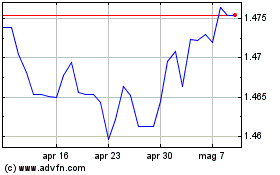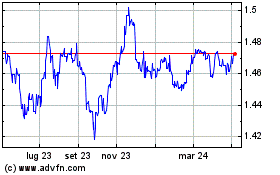Euro Slides Against Majors
19 Novembre 2024 - 8:49AM
RTTF2
The euro weakened against other major currencies in the European
session on Tuesday, as traders are worried that protectionist
policies by President-elected Donald Trump could disrupt the
Eurozone's growth potential.
Trump stated throughout his campaign that all economies will
suffer from the increased import duties imposed by the United
States, but the European Union (EU) will be particularly hard hit.
In the election campaign, Trump advocated imposing tariffs of 10-20
percent on all imports and 60 percent on goods from China.
Fears about the European Central Bank will lower interest rates
by 25 or 50 basis points (bps) at its December meeting has
intensified, due to concerns about Trump's foreign policy.
Rising geopolitical tensions in the wake of Ukraine's use of
Western missiles against Russia, which has led to allegations that
the Kremlin is threatening a nuclear retaliation, also weighed on
the currency.
In economic news, data from the European Central Bank showed
that the euro area current account surplus increased in September
on a rebound in primary income. The current account surplus totaled
EUR 37 billion in September, up from EUR 35 billion in the previous
month. The surplus was forecast to fall to EUR 27.0 billion.
Data from Eurostat showed that the harmonized index of consumer
prices posted an annual growth of 2.0 percent, as initially
estimated. Inflation stood at 1.7 percent in September. Core
inflation that excludes energy, food, alcohol and tobacco, remained
unchanged at 2.7 percent in October, in line with the flash
estimate.
In the European trading now, the euro fell to 4-day lows of
1.0524 against the U.S. dollar and 0.8333 against the pound, from
early highs of 1.0601 and 0.8362, respectively. The euro may test
support around 1.04 against the greenback and 0.81 against the
pound.
Against the Swiss franc and the yen, the euro slid to nearly a
3-1/2-month low of 0.9304 and a 1-1/2-month low of 161.50 from
early highs of 0.9362 and 163.81, respectively. If the euro extends
its downtrend, it is likely to find support around 0.92 against the
franc and 160.00 against the yen.
Against Australia, the New Zealand and the Canadian dollars, the
euro slipped to a 1-week low of 1.6217, a 6-day low of 1.7906 and a
5-day low of 1.4766 from early highs of 1.6300, 1.8016 and 1.4858,
respectively. The next possible downside target is seen around 1.60
against the aussie, 1.76 against the kiwi and 1.46 against the
loonie.
Looking ahead, Canada CPI data for October, U.S. building
permits and housing starts for October and U.S. Redbook reports are
slated for release in the New York session.
Grafico Cross Euro vs CAD (FX:EURCAD)
Da Dic 2024 a Gen 2025

Grafico Cross Euro vs CAD (FX:EURCAD)
Da Gen 2024 a Gen 2025
